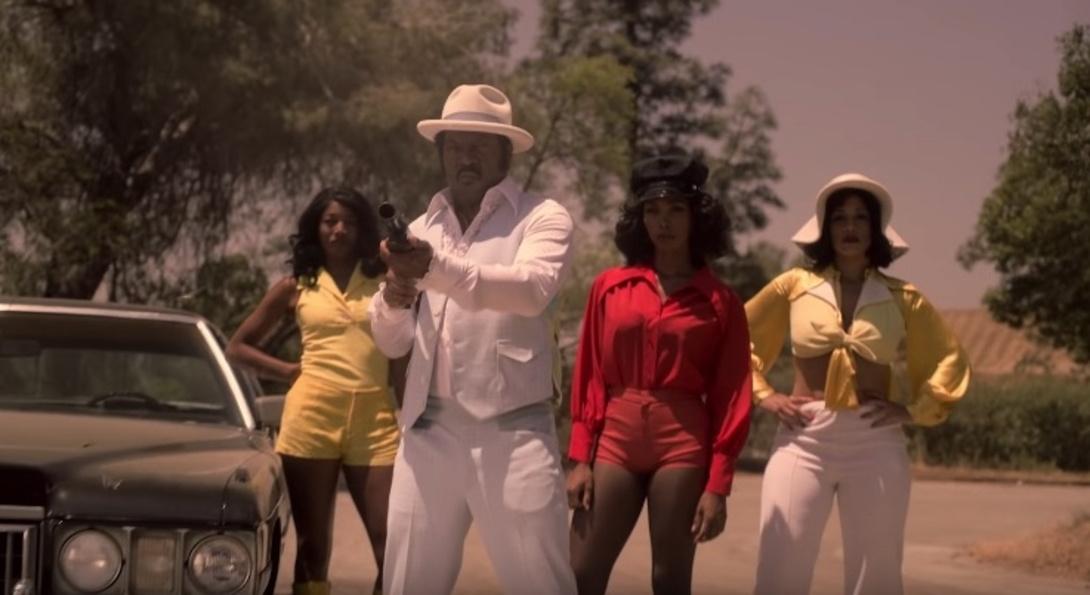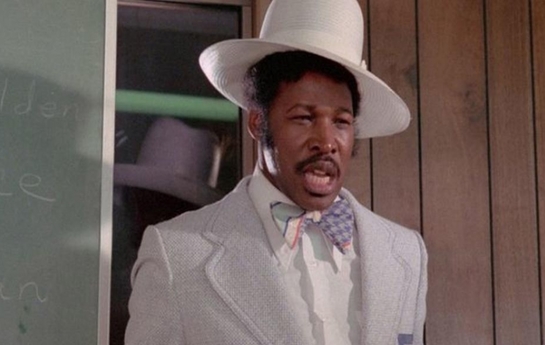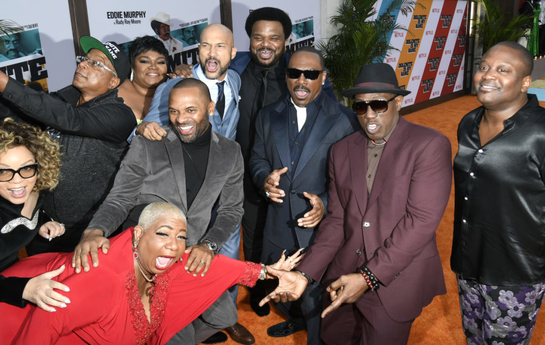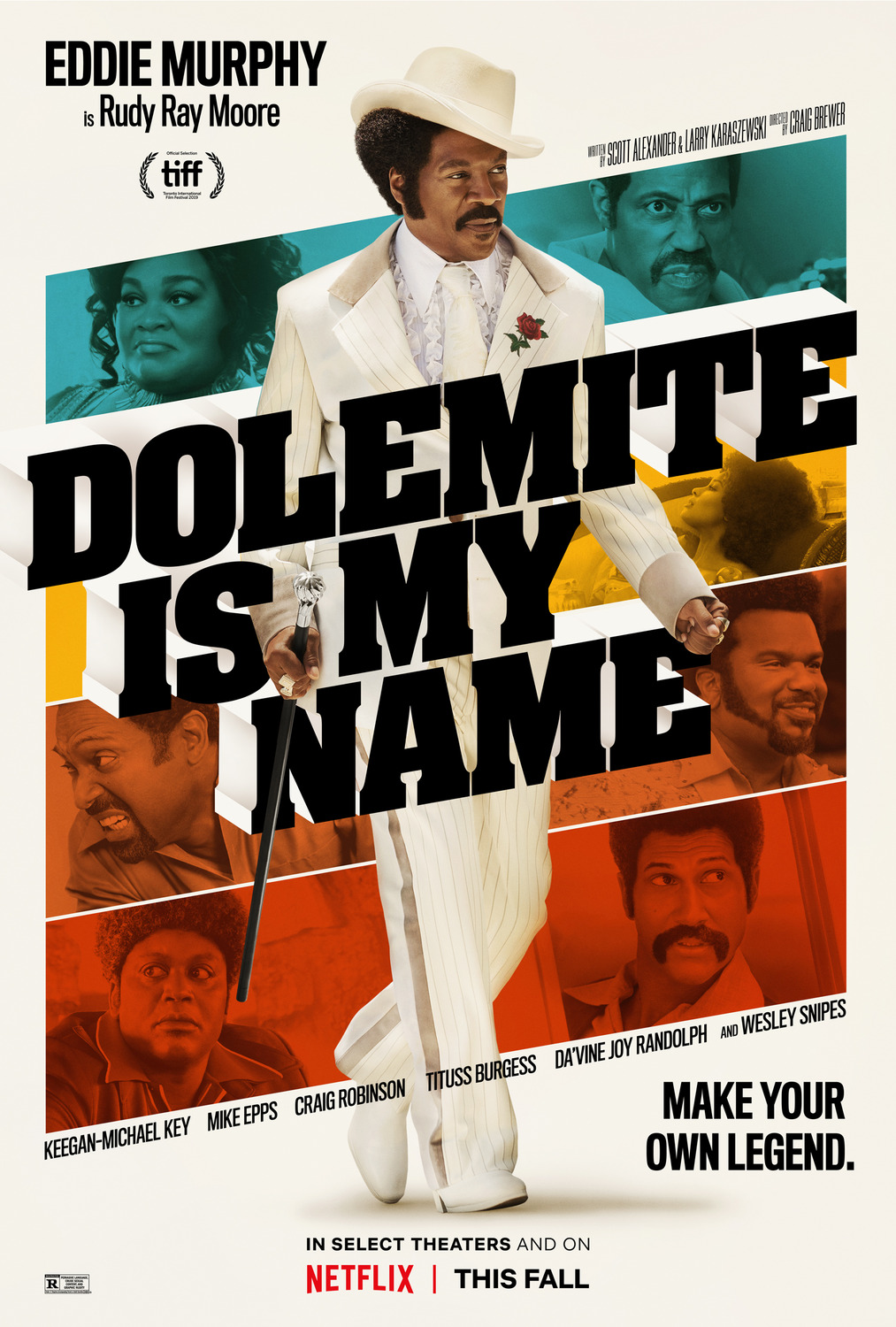The Legend of Dolemite

The Rise of Blaxploitation — For the People, By the People
Witnessing the aftermath of the Civil Rights movement, African American filmmakers and allies were anticipating a significant change in the country and what it could mean for Black stars in White-dominated Hollywood. The '60s introduced a number of potential leading men of color, including Sidney Poitier and Jim Brown, but opportunities remained rare due to the notion that all audiences wouldn't sit through films with a Black perspective. In response, Melvin Van Peebles produced the film Sweet Sweetback's Baadasssss Song (1971) about a pimp on the run after escaping two LAPD officers. The film was met with acclaim from activist organizations, including the Black Panther Party. It had commercial success from the new Black audience heading into urban cinemas to enjoy the pro-black dialogue, and Earth, Wind, & Fire performed the musical score. Nonetheless, downright confusion from the MPAA led to the film receiving an X rating, something that Van Peebles would implement in his marketing as "the movie The Man doesn't want you to see." That same year, Metro-Goldwyn-Mayer (MGM) distributed Shaft to fanfare from all demographics. This unanticipated reaction made Hollywood take notice of the Black market and actively green light projects to cater to the niche audience as these films would start the decade of prominence for Black action flicks.
The ultra-violent crime-thrillers brought larger-than-life characters to cinemas worldwide that put Black talent at the forefront, rather than traditional, played out sidekick acts usually distributed to minority actors. The protagonists served as law enforcement, detectives, private eyes, bounty hunters, street pushers, and yes, pimps and prostitutes. Generally, the hero's journey would be to seek vengeance against the oppression and injustices dished out by the White authority figurehead or system known as "The Man." In transition scenes, the Heros would ride around to the sound of funk music. And while some of the biggest Blaxploitation pictures had input from major Hollywood forces, the majority of films comprised of independently (and minority) produced, low-budget B-movies and grindhouse pictures.
Not everybody, however, was appreciative of the supercharged nature of the films. In Los Angelas, local NAACP head Junius Griffin coined the term "Blaxploitation," taking offense to the raunchy portrayals of African Americans on screen, especially with more major film studios getting involved in the subgenre. In response to films like Super Fly, Shaft, and Sweet Sweetback's Baadasssss Song, Griffin exclaimed that “we must insist that our children are not exposed to a steady diet of so-called black movies that glorify black males as pimps, dope pushers, gangsters, and super males." Starting in the mid-70s, the genre began to elicit more reactions of disproval, especially because of the gritty and dangerous use of tropes about Black people loaned from White America. In time, audiences got tired of the constant themes of explicit sexual activity and extremely violent episodes, and by the 80s, the presence of new Blaxploitation films had faded. The major film studios moved on to producing more White Male led action flicks, while many of the faces who pushed so hard to create lanes for African Americans in the film industry were left without employment.
In the end, Black audiences didn't forget about the contributions of the film pioneers of the 70s. A lot of the films became box office hits from the iconic performances by actors like Pam Grier (Foxy Brown, Coffy), Fred Williamson (Black Caesar, Hell Up in Harlem), Tamara Dobson (Cleopatra Jones) and Richard Roundtree (Shaft), which led to them becoming synonymous with the subgenre. Additional praise was credited to the musical scores in the films that featured top names in soul and funk music, like Isaac Hayes and Curtis Mayfield. and then there were the gifted individuals who could do it all, including one particular man named Rudy Ray Moore.
Rudy Ray Moore's Redemption Story Heading link

Rudy Ray Moore is the mastermind behind the legendary Black entertainment character Dolemite. Born in 1927, his upbringing as a fun-loving entertainer jump-started when he left Arkansas at age 15. Later, while enrolled in the military, Moore would entertain fellow troops by performing jokes and songs, experimenting with different personas. Moore’s rise from fledgling entertainer to comedic genius is documented in the Craig Brewer directed film Dolemite Is My Name (2019), now streaming on Netflix, with Eddie Murphy playing the talented comedian in the R-rated film.
The picture starts with the middle-aged Moore failing to get a radio DJ (Snoop Dogg) to put on an old record Moore made when he was an aspiring singer. The DJ proceeds to knock Moore down to size, citing age as a barrier, saying “We missed our shots.” Moore works two jobs, as a cashier at Dolphins’ of Hollywood with friend Toney (Titus Burgess), and as a comedian/MC at a The California Club with musician Ben Taylor (Craig Robinson) and host Jimmie Lynch (Mike Epps). While at Dolphins, Moore frequently encounters a drunk homeless man named Ricco, who doesn’t see himself as a hobo, but rather “a repository of Afro-American folklore” as he serenades customers with a rhythmic performance of narrative storytelling — called “toasts” — for spare change.
On a particular event, Ricco tells the story about “a little bad motherf*cker named Dolemite.” The Dolemite routine would consist of braggadocios accounts of ungodly strength like “He handcuffed lighting and threw thunder’s *ss in jail.” Moore comes up with the idea to get the local homeless drunk and record their toast sessions. Moore would later develop the ancient jokes and tailor the punchlines to fit into his routine. He would debut his Dolemite act at the California Club with an interpretation of “The Signifying Monkey.” After hearing the roaring approval from the audience, he records his first comedy album, Eat Out More Often, with the same lines rooted in folklore like “Mules have kicked me, and they didn’t bruise my hide. A rattlesnake bit me and then just crawled off and died.” While in Macon, Moore discovers Lady Reed (Da’Vine Joy Randolph) and invites her to be his opener on the stand-up tour.
Creating Dolemite Heading link

While celebrating Christmas on his successful comedy tour, Moore and the gang agree to watch the film adaption of Broadway comedy The Front Page (1974), a picture Moore stated as unappealing for having “no t*tties, no funny, and no kung fu.” Suddenly, Moore thought about the potential in cinema for Dolemite. His commercial success granted him the honor of being the first artist with two comedy albums on the Billboard Top 50 at the same time, and with Blaxploitation in its prime, Moore saw his opportunity to cross over to the big screen. The overwhelming majority of the crew had no previous experience in producing a film, except for a few UCLA film school kids led by director of photography Nick Von Sternberg (Kodi Smit-McPhee). Other roles were filled in by Moore’s friends, with Ben Taylor providing the quintessential part of music composer. Moore recruits socially conscious writer Jerry Jones (Keegan-Michael Key) and reluctantly scores well-established actor D’Urville Martin (Wesley Snipes), who agrees to make his directing debut on the project and portrays the main antagonist, Wille Green.
The plot to Dolemite (1975) involves the braggadocious pimp and club owner getting released from his 20-year sentence, and with the assistance of Lady Reed’s Queen Bee Character, plots his revenge on Wille Green, the street rival who set Dolemite up. What followed proved to be a horrendous filming experience for all involved. Filming primarily took place in The Dunbar Hotel, a building with a significant history in the African American community that once hosted events and concerts by Billie Holliday and Louis Armstrong. Unfortunately, the building succumbed to hard times, and after it closed its doors in 1974, it became home to homeless squatters and illegal activity. Moore worked out a deal with the landlord for rent-free use of the hotel, which didn’t have running water or electricity to power the filming equipment, so the crew had to hijack a power supply from a next-door building. Additionally, the building was in horrendous shape and the flooring would sink from the pressure of the camera’s tripod. The writing proved to be incoherent also, as Moore would constantly ad-lib in new lines, turning Jones’s thriller based dialogue into slapstick comedy. While directing, D’Urville Martin would drunkenly belittle cast and crew, citing his belief that the movie was always going to be a failure. By watching Dolemite, you can spot the immense mistakes from the inexperienced crew, as production equipment and boom mics become visible in multiple scenes. On top of that, the bulk of the actors were amateurs — like “The Hamburger Pimp,” who was a real-life drug addict hired on the day of shooting to film scenes.
The finale to Dolemite finds the protagonist brawling with Willie Green in the lobby of a club while Queen Bee commands the “All-Girl Army of Kung Fu Killers” to take out Green’s henchmen. Dolemite corners Green, rips his guts out with his bare hands, and allows FBI Agent Blakely, played by Jerry Jones, to shoot Green, pinning the death on him. After the final “cut” Martin congratulates the crew for wasting his time and storms out of the Dunbar set to pursue more professional projects. Just like Moore’s comedy albums, critics would pan the film’s extremely low-brow humor and vulgarity as reasons to avoid watching it. Upon the initial premiere, Dolemite was universally panned. While bad reviews did hurt Moore, alternatively he saw marketing gold in the bad press for creating intrigue to see how crude and vulgar the film is. The tagline used to develop interest was “Bone-crushing, Skull-splitting, Brain-blasting ACTION!” and this would work out, as Dolemite made over 12 million dollars (compared to the $100,000 budget) and became one of the biggest films of the decade.
Moore's Legacy in Black Art Heading link

Rudy Ray Moore’s X-rated comedy routine would continue to push barriers for years to come. His work would motivate other comics to take more risks in their films and stand-up specials. Critics would change the tone on Moore’s work after the Blaxploitation period ended, with the New York Times writing in 2002 that Dolemite “remains the ‘Citizen Kane’ of kung fu pimping movies.” On top of his 32 comedy albums, Moore would go on to produce several more Dolemite related films, Including The Human Tornado, Petey Wheatstraw, and Disco Godfather before passing away in 2008 at 81 years old.
In addition to his comedy legacy, Moore is hailed as representing another figure: the Godfather of Rap, as MC’s would adopt his rhythmic delivery and persona. Rapper Big Daddy Kane cites the comedian’s delivery as inspiration for his own. On the other side, rappers saw Moore’s pimp image as a renegade to traditional society, wearing colorful, flashy clothing and the iconic wide-brimmed hat. Other rappers and Hip-Hop figures to acknowledge Moore are Dr. Dre, Busta Rhymes and Snoop Dogg — who besides appearing in the Netflix biopic, thanked Moore in liner notes to the 2006 release of the Dolemite soundtrack, saying “without Rudy Ray Moore, there would be no Snoop Dogg, and that’s for real.”
In brief, Moore’s willingness to bet on himself no matter how financially bleak his situation yielded amazing success for him and inspired generations of African American performers.
Dolemite is my name. And rappin’ and tappin’, That’s my game. I’m young and free. And just as bad as I wanna be
Clip from movie Heading link
Plug Time Heading link
———————————————————————————————————————————————————————————————————————————————————————
Thank you for reading!!! Follow me on social media at:
ig: @carpizzy
Twitter: @CarpIzzy
Snapchat: izzy_carp224
Facebook: israel.carpenter.3
